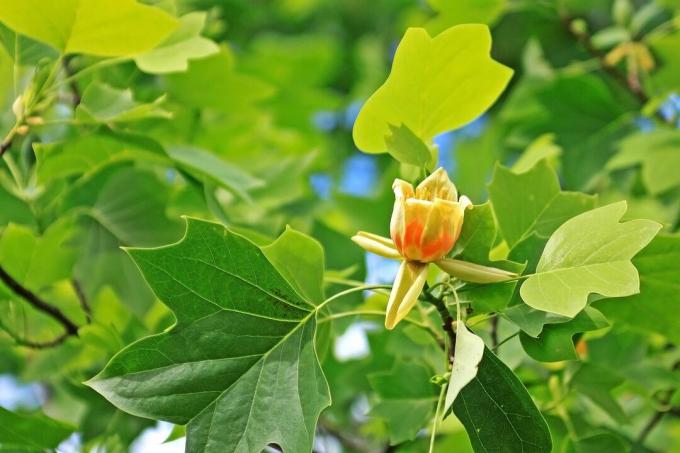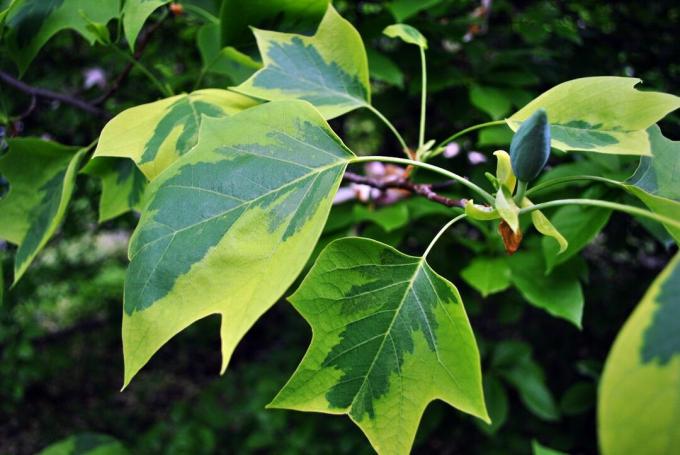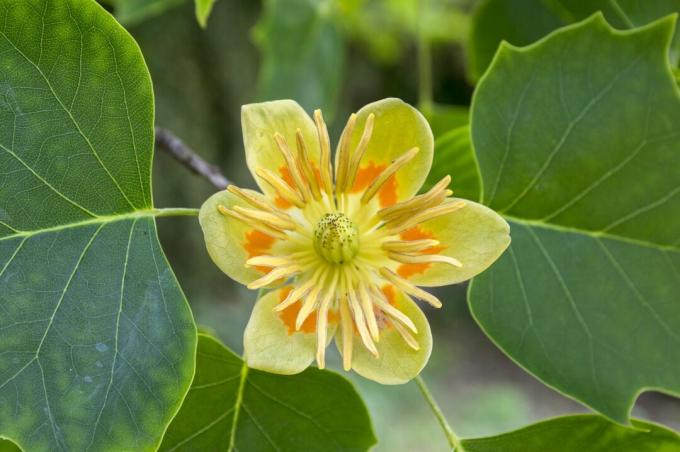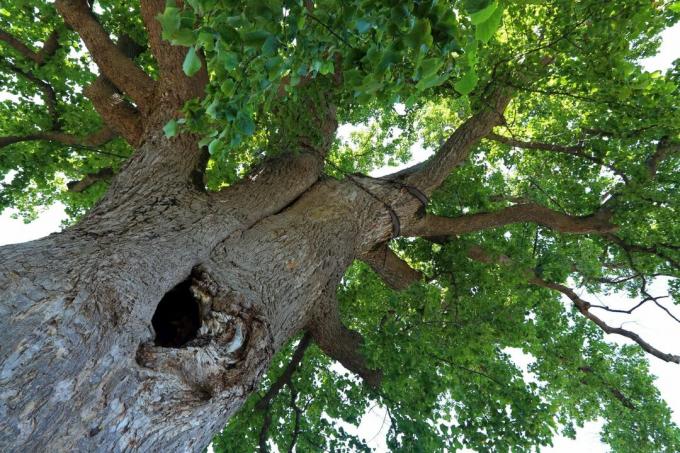The tulip tree has a lot to offer. In addition to the characteristic tulip tree blossoms, it also has special leaves and impressive autumn colors.

The American tulip tree (Liriodendron tulipifera) is one of the noblest and most important forest trees there. It is also very popular in Germany. Here you can find out everything about planting and receive tips for the optimal care of the tulip tree.
contents
- Tulip tree: flowering, origin and characteristics
- The most beautiful species and varieties
- Planting a tulip tree: location and procedure
-
Proper care
- Fertilize and water the tulip tree
- Pruning tulip tree
- Tulip tree does not bloom
- Transplant tulip tree
- Propagate tulip tree
- Is the tulip tree hardy?
- Common pests and diseases on the tulip tree
- Is the tulip tree poisonous?
Tulip tree: flowering, origin and characteristics
The tulip tree is a deciduous tree and, like the magnolia (Magnolia), to the magnolia family (Magnoliaceae). It comes from the Northeast America and is widespread there. It is also gaining more and more popularity in Germany. The specialty of the tulip tree is - as its name suggests - the beautiful bloom that is reminiscent of tulips. The tulip tree flowers have a calyx-like shape, yellow-orange petals and appear from May to June. After pollination, elongated, cone-like fruits develop. The four-lobed leaves of the deciduous tree have a characteristic, symmetrical shape and turn a long-lasting gold in autumn. The fast-growing tulip tree can grow up to 40 meters tall and then usually forms a columnar crown. As a heart root, it prefers deep, moist and humus-rich soils.

Is the tulip tree friendly to bees? The tulip tree blossoms contain plenty of nectar, which is not only consumed by bees, but also by beetles, bumblebees, butterflies and other insects.
The most beautiful species and varieties
Only two species belong to the genus of tulip trees, the Chinese and American tulip trees. However, there are also some varieties of tulip trees that differ primarily in terms of growth form and size.
- Chinese tulip tree (Liriodendron chinense): The Chinese tulip tree occurs in Asia and forms together with Liriodendron tulipifera the genus of tulip trees (Liriodendron). A big differentiator to the Liriodendron tulipifera is on the one hand the lower stature and on the other hand the larger lobed leaves.
- Columnar tulip tree (Liriodendron tulipifera "Fastigiatum"): With its 6 to 8 meter wide crown and a height of 15 to 18 meters, this tulip tree grows in a columnar shape. It is therefore also known as the columnar tulip tree and remains a lot smaller than the wild species Liriodendron tulipifera.

- Yellow-colored tulip tree (Liriodendron tulipifera ‘Aureomarginata’): At 12 to 15 meters, this variety remains a bit smaller and grows a lot more slowly than the wild species. The two-colored leaves are dark green with a light to yellow-green edge.
- Dwarf tulip tree (Liriodendron tulipifera ‘Ardis’): This dwarf form of the tulip tree is only 8 to 9 meters high and is therefore also suitable for gardens with less space.
By the way: The African tulip tree (Spathodea campanulata) is not closer to Liriodendron related, but belongs to the trumpet tree family (Bignoniaceae). It also has showy, cup-shaped flowers.

Planting a tulip tree: location and procedure
The tulip tree thrives best in a sheltered location with sunny light conditions. The soil should be loose, rich in humus, not too calcareous and, above all, deep. In addition, the tulip tree likes a well-drained and not too dry subsoil. The roots need a lot of space to be able to spread.
The tulip tree is best planted in March. It is very advisable to tie the young tulip tree securely to two stakes so that it is not moved by the wind. Namely, this hinders good growth. The planting hole should be twice as wide and deep as the root ball. During the preparations, place the tulip tree in a bucket of water so that the root ball can soak up. Then put a nutrient-rich, loose substrate in the planting hole and mix it with the garden soil. Here, for example, ours is suitable Plantura organic universal soil, which contains all the important nutrients and thus promotes healthy root formation.

The soil in the planting hole should now be moistened. Then the tulip tree is placed in the hole and the gaps are filled with garden soil and potting soil. Press everything down firmly and model a watering rim out of the excess soil so that the tulip tree can be effectively watered.
Tip: In the case of bare-root or balled tulip trees, a plant cut should be made directly before planting. Because with these tulip trees the root ball is greatly reduced in size shortly before the sale, which leads to better growth, but also to a disproportion between roots and crown. So that the tree does not evaporate more water above ground than it can absorb underground, the crown should be reduced a little.
Proper care
The soil should be kept as moist as possible, especially in the first few weeks and the first summer after planting. It is important to avoid waterlogging. A layer of bark mulch protects the earth from drying out in summer. In the first growth phase, the tulip tree can also be protected from pests with a fleece.

Fertilize and water the tulip tree
The tulip tree needs enough water to produce plenty of leaves and beautiful flowers. If it doesn't rain enough, it has to be watered every now and then - especially in midsummer.
In late spring, young trees should be provided with fertilizer. A slow release fertilizer, such as ours Plantura organic universal fertilizer, provides the plants with nutrients for at least three months, which are gradually released. It is simply sprinkled on the ground and easily incorporated or covered with mulch for improved effectiveness. Caution is advised here with the tulip tree, as the fine roots close to the surface of the earth are very sensitive and can be injured during tillage.
Pruning tulip tree
It is not necessary to cut the tulip tree as it develops its typical crown shape naturally and without any intervention. The tulip tree is sensitive to pruning. It is therefore advisable to choose a suitable variety for the space available. In spring, however, sick or dead branches can be removed regularly.
Tulip tree does not bloom
The first flowers often only appear when the tree is 20 to 30 years old. If the flower does not bloom despite reaching this age, it could be the result of a lack of water, space or light or a radical pruning. It is therefore important to choose a suitable location and take good care of the tulip tree.
Transplant tulip tree
Transplanting the Liriodendron tulipifera is not recommended due to the very sensitive roots and the depth of the roots.
However, if you decide to do so, dig up the root ball as generously as possible so as not to damage it. If the specimen is larger, it should be pierced deeply around the root ball a year before transplanting. This promotes branching of the roots close to the trunk and creates a denser root ball, which makes it easier to grow in the new location. Alternatively, a trench can be dug and a root barrier buried. The transplanting itself should then be done in spring. If the ratio of crown to root ball has changed significantly, a new plant cut should be carried out to protect the tree from too much water loss.

Propagate tulip tree
Propagating the tulip tree is not easy and requires a lot of patience. The wild species is only propagated by sowing, but you can rarely buy tulip tree seeds. Alternatively, it is possible to harvest seeds from an existing tulip tree. You can grow the seedlings on the windowsill or in a warm greenhouse from September. The seeds are scattered on potting soil, moistened and covered with cling film. The germination temperature is 20 to 26 ° C.
Cuttings can also be used to propagate the tulip tree. Unfortunately, this method offers little chance of success, but it is worth trying. To do this, cuttings from annual shoots growing close to the stem and near the ground are cut at an angle in June or July. These are placed in potting soil and kept warm at 20 to 24 ° C. Then put a plastic bag over the container and keep the cuttings well moist.

Is the tulip tree hardy?
The applies in Germany Liriodendron tulipifera as absolutely hardy and does not require any further protective measures.
Common pests and diseases on the tulip tree
The tulip tree is hardly affected by diseases and pests. However, if the subsoil is too wet, root rot can occur. Spots on the leaves are mostly due to dryness.

Is the tulip tree poisonous?
All parts of the tulip tree are poisonous, both for humans and animals. Small children and animals should be taken to the doctor or veterinarian if they are suspected of being consumed.
Magnolia and tulip tree belong to the same family of plants and both impress with their splendor of flowers. How do you Plant and care for magnolia, learn from us.



